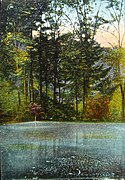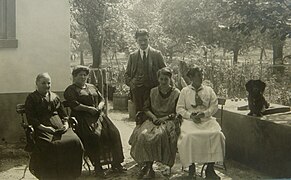Brine baths in Mumpf
The brine baths in Mumpf were baths with salty water ( brine ) in the Aargau village of Mumpf (Switzerland), which were in operation from 1854 to 1991. The brine came from the nearby Rhine saltworks near Riburg .
history
Until the middle of the 19th century, the people in the village of Mumpf earned their daily bread mainly as raftsmen , fishermen and boatmen on the Upper Rhine . However, with the advent of road and rail traffic, work on the Rhine decreased. The mumpers seized the opportunity for other work that was offered by the new "fashion" of the spa . They ushered in the 140 year history of the Mumpf health resort.
First Mumpfer brine bath: Badanstalt des Pintwirt Mösch
The origin of the Mumpfer baths goes back to the year 1854. This can be found in the documents in the state archive of the canton of Aargau: Pintwirt Mösch received the first license to administer pool baths in a bath tub on July 3, 1854 . The permit had to be renewed every year. The Landammann personally signed these resolutions of the Government Council . After the Pintwirt's death, the government transferred the license to the widow Mösch in 1860 : the approval of the purchase of Salzsoole for a bathtub at the Mumpf bathhouse, for which an annual fee of CHF 8 Rp.50 is to be paid to the Rheinfelden district administration Widow Magdalena Mösch b. To transfer Schlageter to Mumpf or to renew it for the current year. Execution tax of Fr. 5.-. Even after the death of Magdalena Mösch, the bathroom remained in the possession of the family, managed by Siegfried Tschudy-Mösch.
The pint, built in 1829, was given the name «Anker» before 1900. In the hotel's own prospectus from 1920, the village and the location of the hotel receive high praise as an excellent climatic health resort: the Rhine and the forests require pure, healthy air. There is an opportunity for wonderful walks. In the middle of orchards and directly adjacent to the Rhine, the brine bath at Anker is located . The hotel offered 16 beds in 8 simple and friendly bedrooms, a recognized excellent kitchen, seven brine baths, a carbonated bath, the cozy backyard and a lawn on the Rhine.
Second brine bath: inn and brine bath "Sonne"
The «Sonne» inn is noted as the oldest tavern in Mumpf. Rachel Felix was born here in 1821 , and on August 23, 1829 the composer Robert Schumann was our guest for lunch. He wrote in his travel report: Lunch in Mumpf - good - the withered, grieving widow - leather conversation - livelier - u. their languishing Feuerblike - the good Lucerne merchant - lots of wine - the Frickthal .
In the help book for travelers , JJ Leuthy writes about the "sun": This inn is located in the village of Mumpf, next to the church, on the highway from Basel to Zurich, Aarau, Schaffhausen, where you can sit with the passing express cars every day. The rear façade has a view of the Rhine, on which ships and rafts go to Basel every day; this trip on the Rhine is particularly strange because of the so-called Rhine vortex between Mumpf and Rheinfelden . Nice, new furnished rooms, as well as 2 lounges, which are also suitable for families, a good kitchen, as well as a coach house and adequate stables for 50 - 60 horses, along with the cheapest prices, are the recommendations of this inn.
Sonnenwirt Franz Josef Waldmeyer Sohn set up his inn as a pool bath in 1867, only to significantly increase and expand it 10 years later. The initial number of 15 rooms was expanded to 36 guest rooms with a total of 60 beds. 10 bath cells were on the ground floor. An open gallery facing the hotel garden and the Rhine with a pavilion served the contacts among the spa guests. The dining room also faced the Rhine. A reading room with a large library was also available to the guests.
Together in 1867, Pintwirt Siegfried Tschudy and Sonnenwirt FJ Waldmeyer praised their spa houses, the effect of the brine and the healthy location of Mumpf in a 14-page brochure.
Sonnenwirt Waldmeyer completed extensive series of lectures on his spa hotel throughout Switzerland under the title Soolbad and Gasthof zur Sonne in Mumpf am Rhein, Bötzbergbahn station between Zurich and Basel, given by FJ Waldmeyer. He also had his lectures printed as brochures. From 1881 he also added 155 centimeters long prints of the Panorama von der Fluh near Mumpf , a lithograph by H. Burger-Hofer. Waldmeyer was also full of verve in other ways. He had strolling paths built in the “Bachthäli” as well as a pond with a fish farm and an offer for gondola rides.
Third brine bath: "Hotel Solbad Schönegg"
The "Rötehof" was built west of Mumpf in 1845 as a large farm . In 1892 Johann Peter Bretscher bought the company. In 1893 he received the right to tavern and at the turn of the century he also offered brine baths, first in the laundry room of the farm, which was reached through the stable. A small spa hotel was later built by adding guest rooms. After the fire of 1926, the «Kurhaus Solbad Schönegg» was completely redesigned. The "Schönegg" received a good reputation from far and wide, also for the view over the Rhine valley.
In 1972 a modern swimming pool of 10 × 25 meters for 34 ° C warm brine water and a wide range of other relaxation and therapy options was built. At the same time, the Mumpf- Möhlin Postbus line now made an extra loop three times a day, stopping at Schönegg.
After the hotels "Anker" and "Sonne" no longer offered brine baths between 1950 and 1960, when the "Schönegg" was closed in 1991, the spa town of Mumpf was finally history.
Cure offers
Was the contemporary spa offer from before the turn of the 19th and 20th centuries tub baths, massages , circular showers, local showers, inhalations , gargling , milk cures and headlocks .
In the Kur-Zeitung No. 15 from 1930, the following were indicated as indications for a saltwater bath in the Fricktal :
A salt bath cure is particularly indicated in the following cases: With rheumatism of any kind, wherever it is, gout , bone and joint ailments, as a result of injuries or illnesses. In the case of women's ailments and their consequences, a brine bath often has wonderful healing powers. In the case of nervous disorders resulting from exertion, colds, injuries and poisoning. With weak, anemic, retarded children with glandular or skin diseases , the success is astonishingly good in most cases. For heart sufferers have carbonic -Bäder yielded in connection with Sole very good results. The brine is also used for bubble baths, wraps , inhalations, injections , pouring over, gargling etc. - drinking cures . Depending on the doctor's prescription, it is used diluted or undiluted; the duration and temperature of the various applications also change depending on the nature of the patient's illness. Other cure remedies are showers, whirlpool baths, carbon dioxide, bran and incandescent light baths, hand and electro massage.
The brine used in the spa town of Mumpf came from the Rhine saltworks in Riburg on Rheinfeld soil. Horse-drawn vehicles picked up the brine in barrels in Riburg below the Möhlin train station. The brine from the Riburg salt works is known as the strongest brine on the continent .
From 1929 onwards, the spa newspaper for the health resorts Möhlin-Riburg, Mumpf and Laufenburg was published every Sunday during the season . The Mumpfer teacher Siegfried Wunderlin was the editor . The 16-page sheet wanted to inform and connect the guests. The lists in the edition of August 17, 1930 showed Mumpf 103 spa guests. Mentioning all guests by name and origin gave the spa business a family atmosphere. There were guests from St. Maurice, Basel, Pregassena and Bucarest for the Hotel "Sonne", Basel, Neftenbach, Zurich, Chur and Hinwil for the Hotel "Anker" and Winterthur, Biel, Oerlikon and Bern for the Hotel "Schönegg". In addition to smirking stories, 74 advertisements of various kinds tried to encourage guests to go shopping, take a trip or stop for a break.















